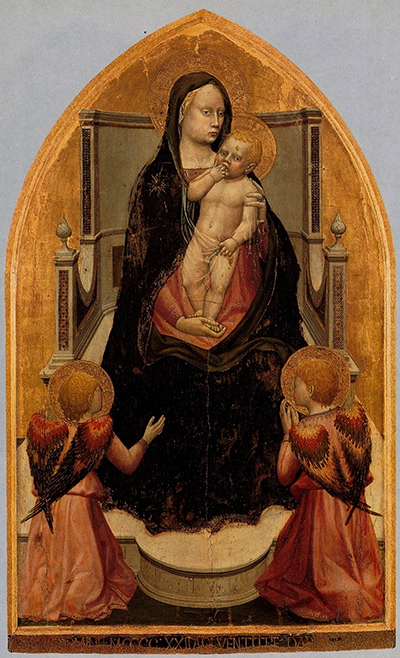The captivating altarpiece of the Virgin Mother Mary by Renaissance artist Masaccio is an incredible illustration of the essence of art.
The artwork dates back to 1442 where the artist was commissioned to depict murals for the Chapel of San Giovenale.
The fresco painting is placed as the central alter piece within the chapel, as Masaccio's other work surrounds it. An Italian family titled the Florentine family, had hired Masaccio to create a life altering mural to showcase.
A date translating to April 23rd 1442 is writing at the bottom of the painting, allowing historians to pin point the exact date of conception for the artwork. Another paintings that Masaccio was commissioned to create include Maria and Child, and Crucifixion.
The central panel showcases the Madonna enthroned by two other angels on her side. Mother Mary is seated in an upright position as her body is incredibly elongated. Masaccio had depicted her in this large form in order to showcase her grand significance within the Roman Catholic religion.
The interesting element to note within the artwork is the colours that Masaccio had used in order to depict the woman. The artist focuses on using a dark textile in order to cloth Mother Mary, differing from the classic blue and red shades he usually depicts her in; as illustrated in his paintings Maria and Child, Madonna of Humility, and Madonna of Casini. All of these depictions of the Virgin Queen manifest her pure presence in the welcoming shades of blue and red.
However the black textile that Masaccio drenched Mary within San Giovenale Triptych Central Panel, greatly differs from the colours the viewer is accustomed to. An array of questions arise as the mysterious colour alters the emotion of the artwork. Perhaps the artist desired to depict a more powerful illustration of Mother Mary, or desired to prevent her innocent form. The artist seems to keep a glimpse of the red fabric he usually uses for the shirt of Mary, however dilutes the colour to a pastel form.
Jesus Christ is seated at the hands of the Virgin Queen as she holds him while he leans against her trying to stand. The child eats grapes from a vine, which are meant to symbolism the holy Eucharist as the body of Christ.
The most important element to witness within the painting is the brilliant artistry of Masaccio as he is able to depict a soft while sheer fabric that the baby clogs onto, on top of the black textile Mary is clothed in. In order for an artist to achieve the portrayal of a sheer fabric, they must hold immense skill and a gifted touch. As Masaccio was believed to have not received any formal education, his incredible ability to be able to portray this piece of fabric showcases why he is known as the forefather of Renaissance Art.
Two angels are placed at the feet of the Madonna turned away from the viewer. These angels kneel as they pray and praise to the Devine entities. Interesting character to notice is the lack of emotion painted across the mother and child's face. Neither characters acknowledge the angels praise as the Madonna is seized by an object in the distance and the child eats the holy grapes.
Masaccio continued to display characters of Italian architecture throughout his artwork, as the structures are in fact a part of the scene. Gothic arches fill the top of the painting, while. Ring bathed in a deep golden colour. Folds and columns swerves around the alter at which the couple is seated at, accentuated by intercut detail in each stone.




